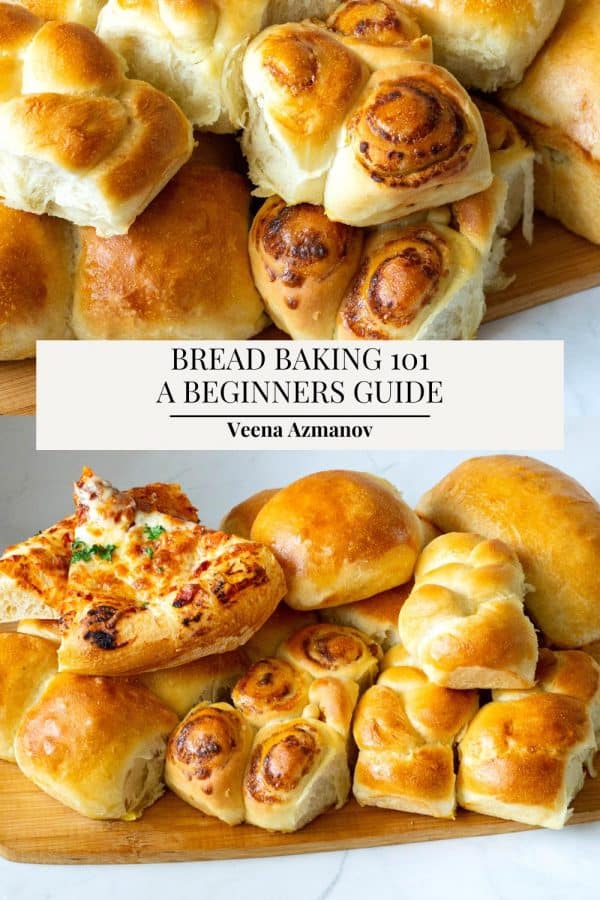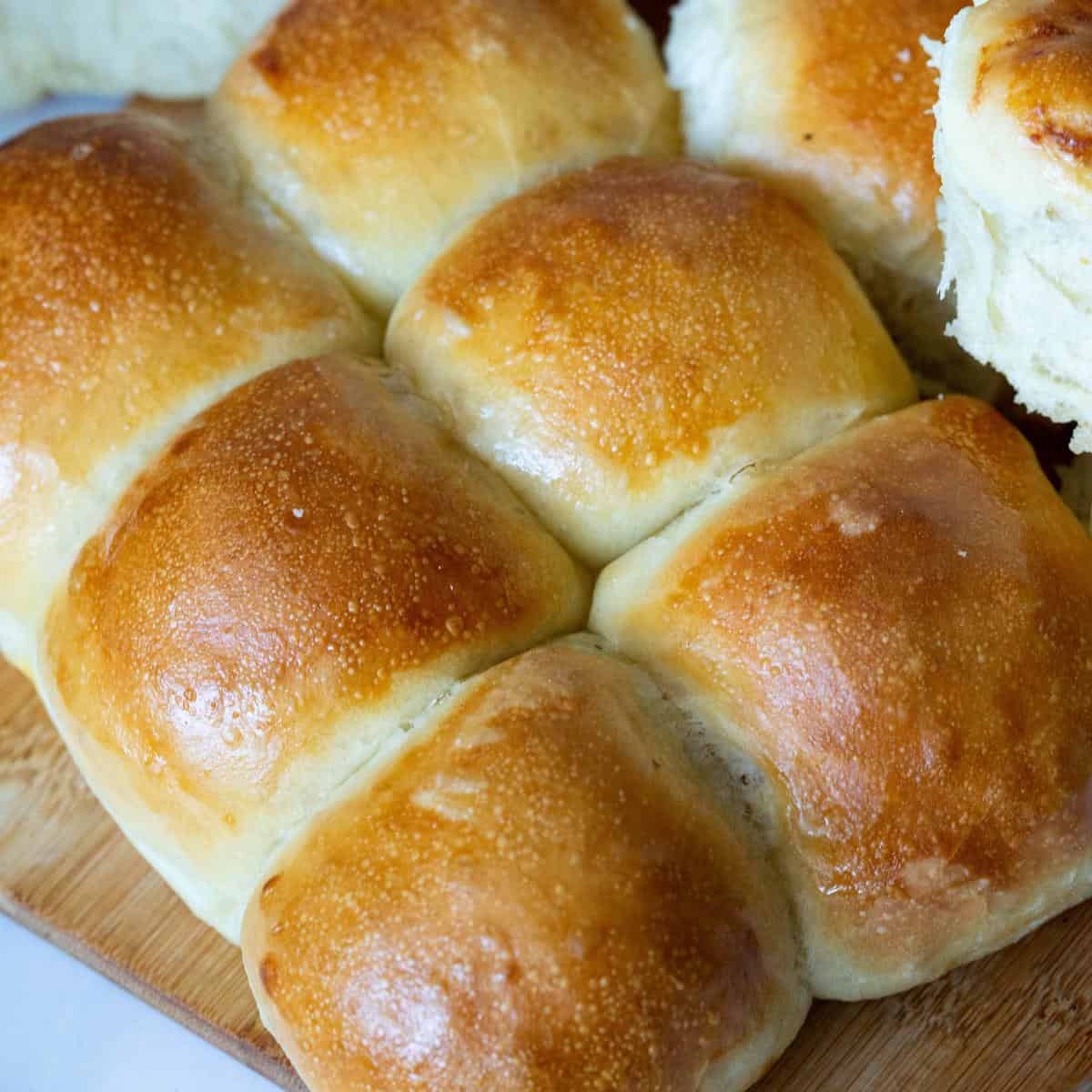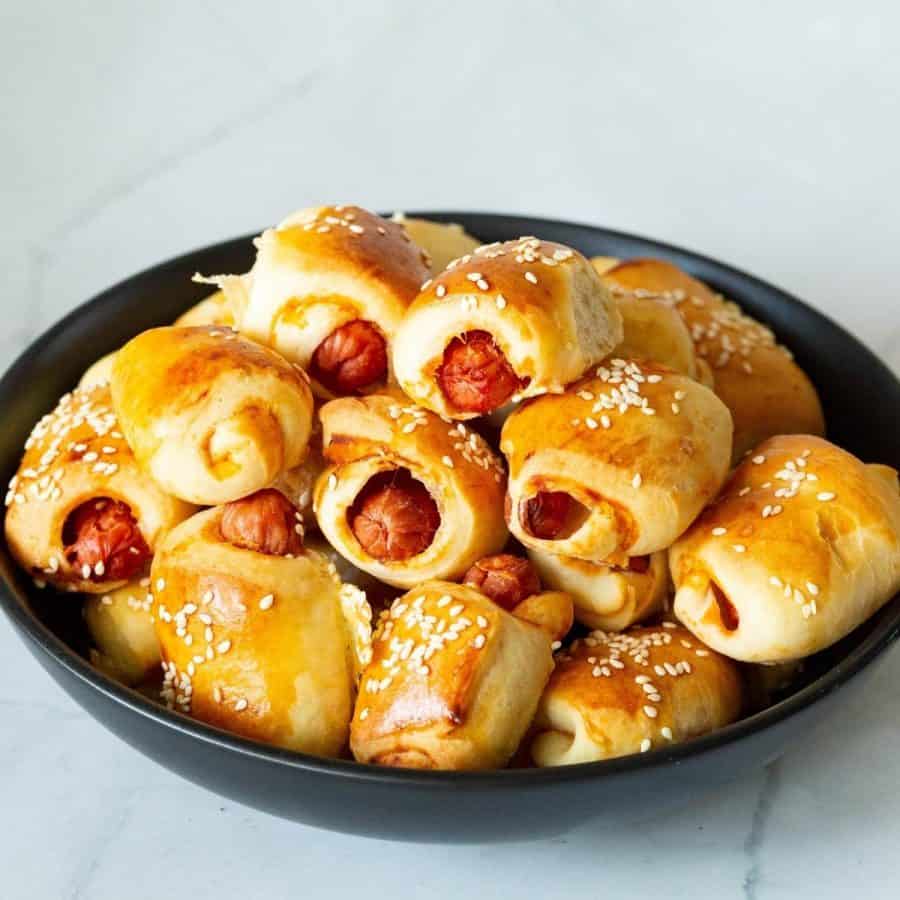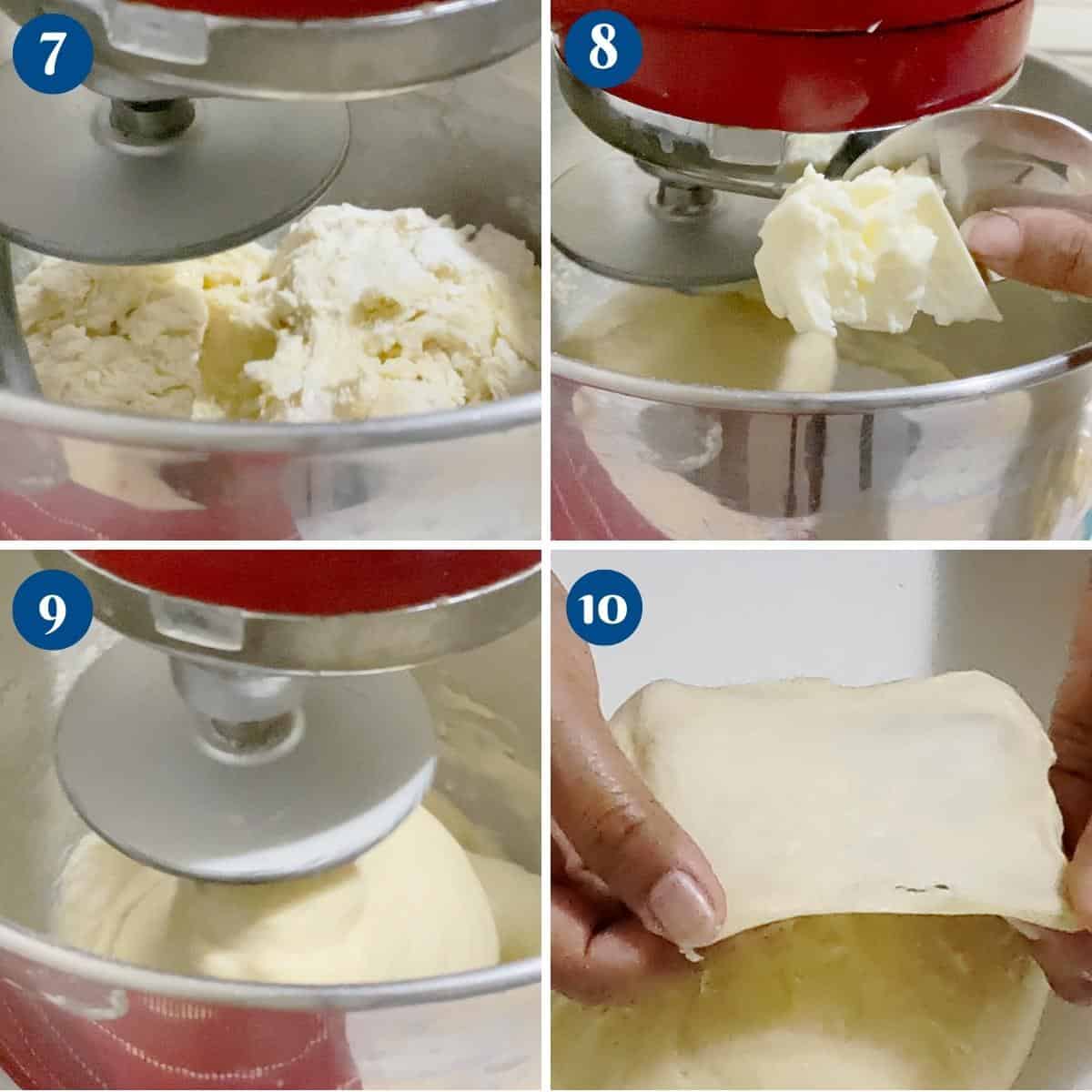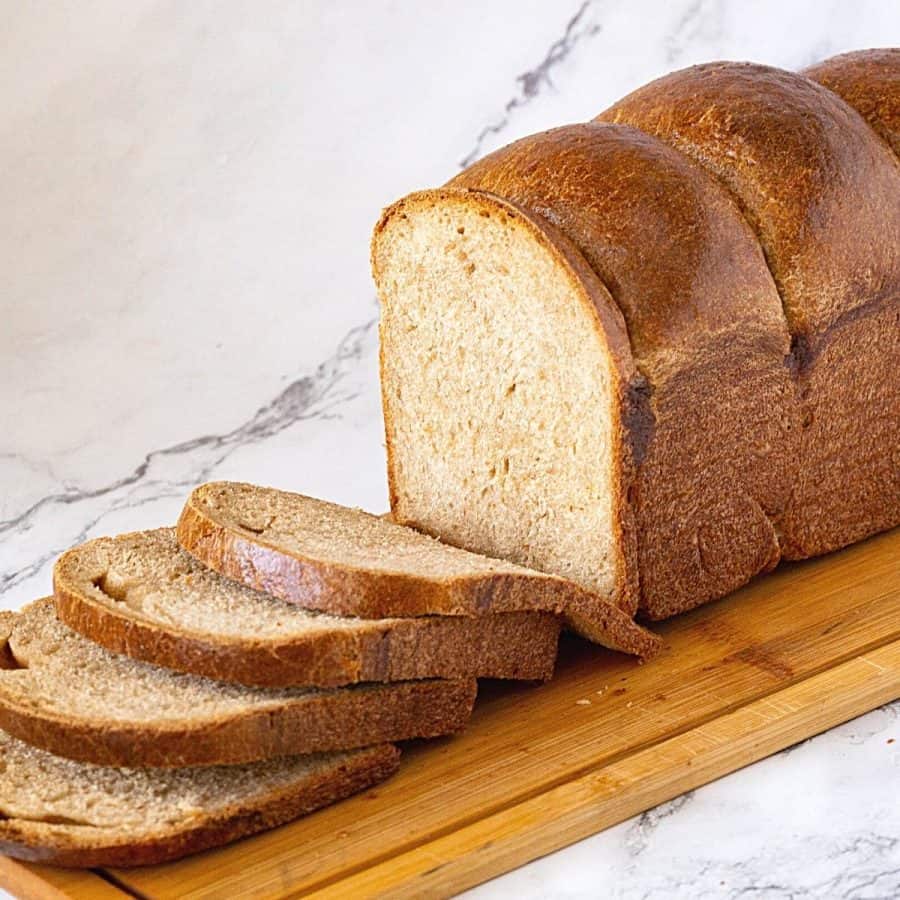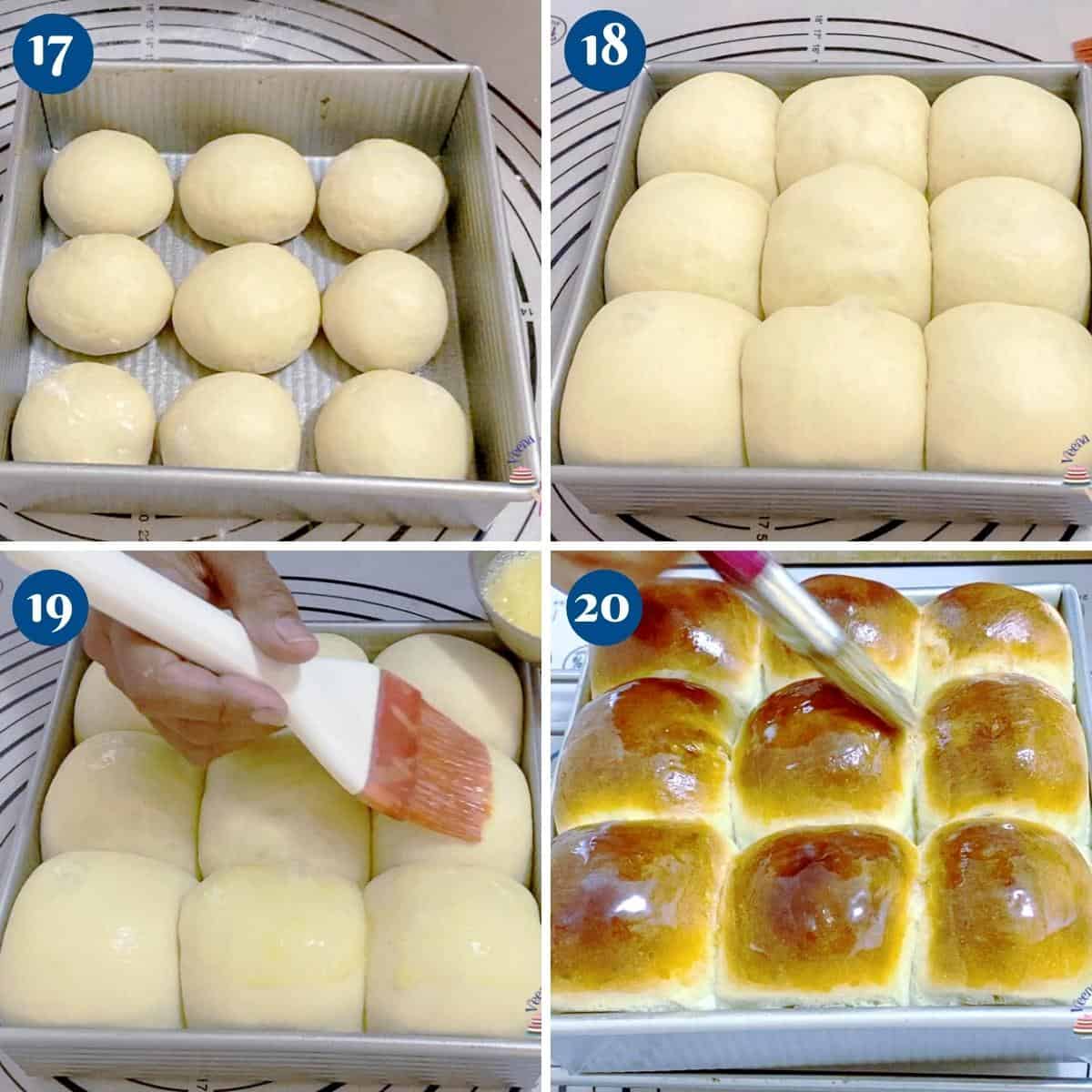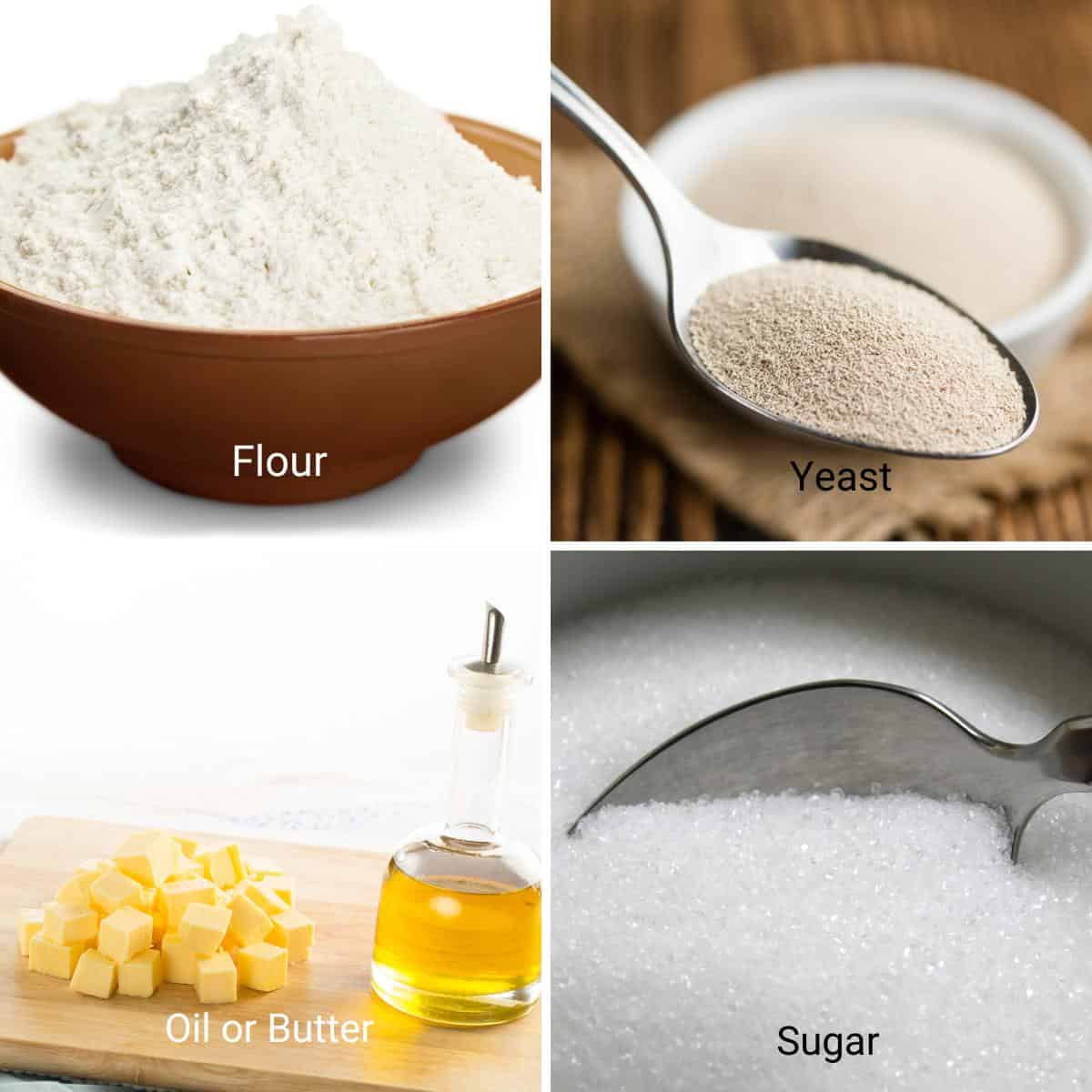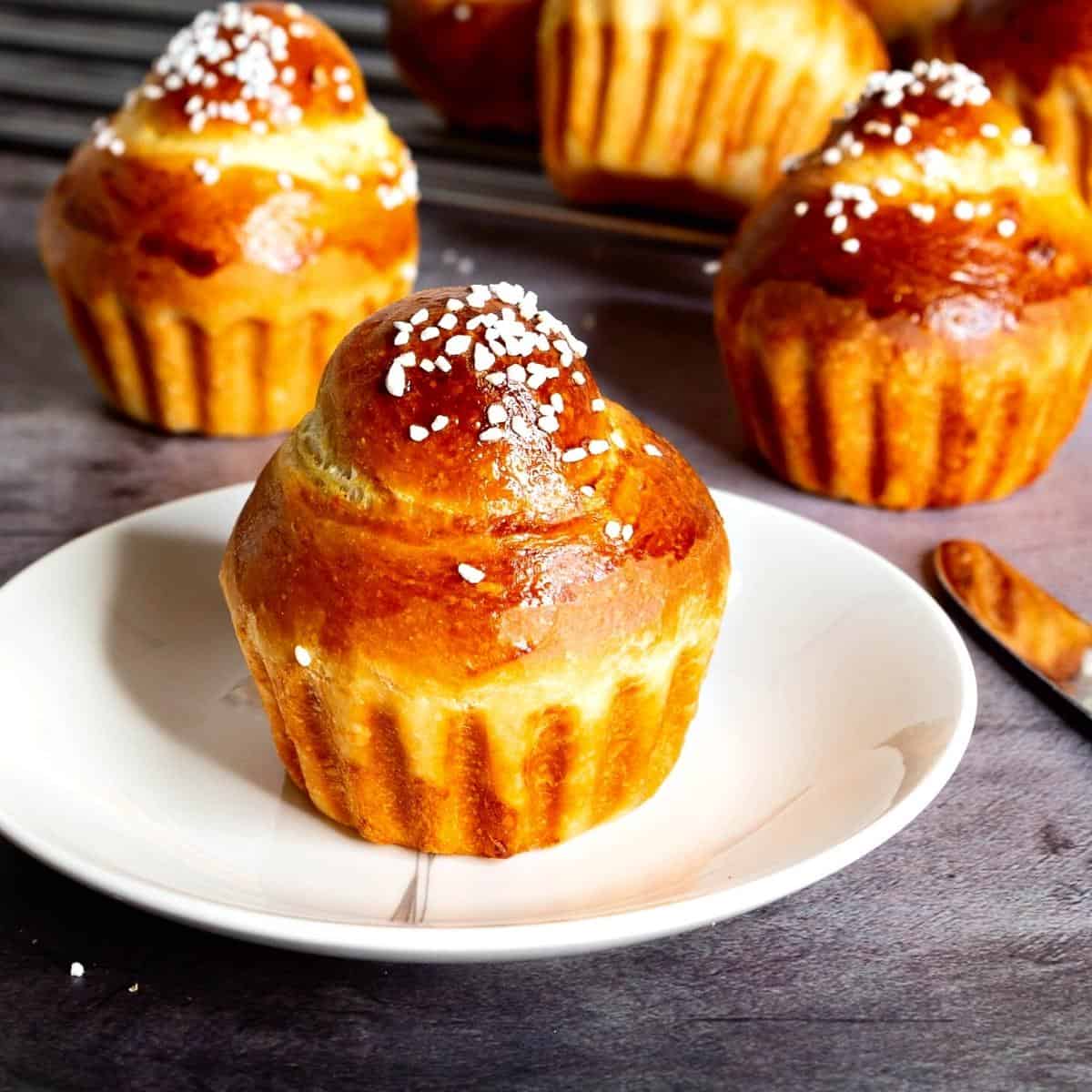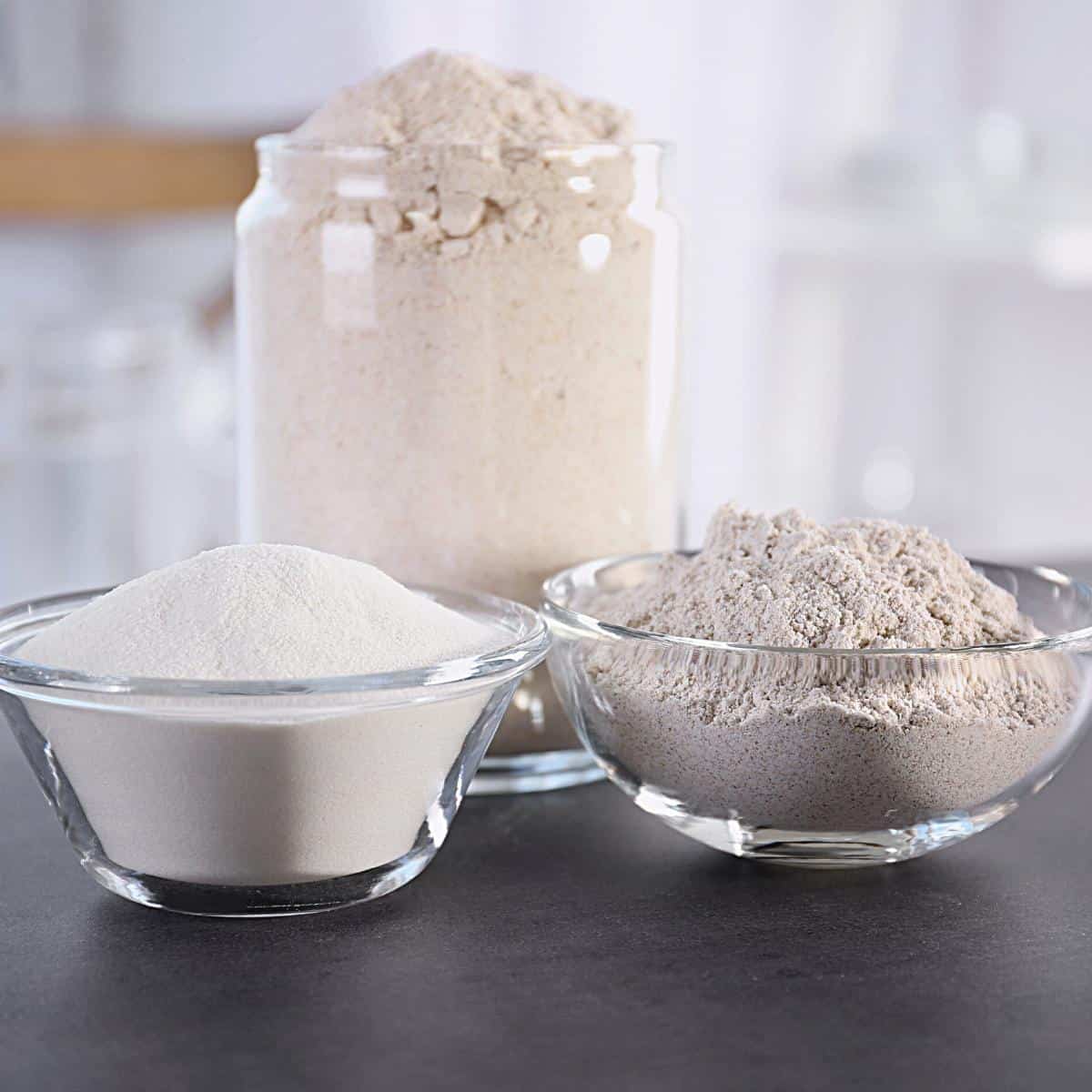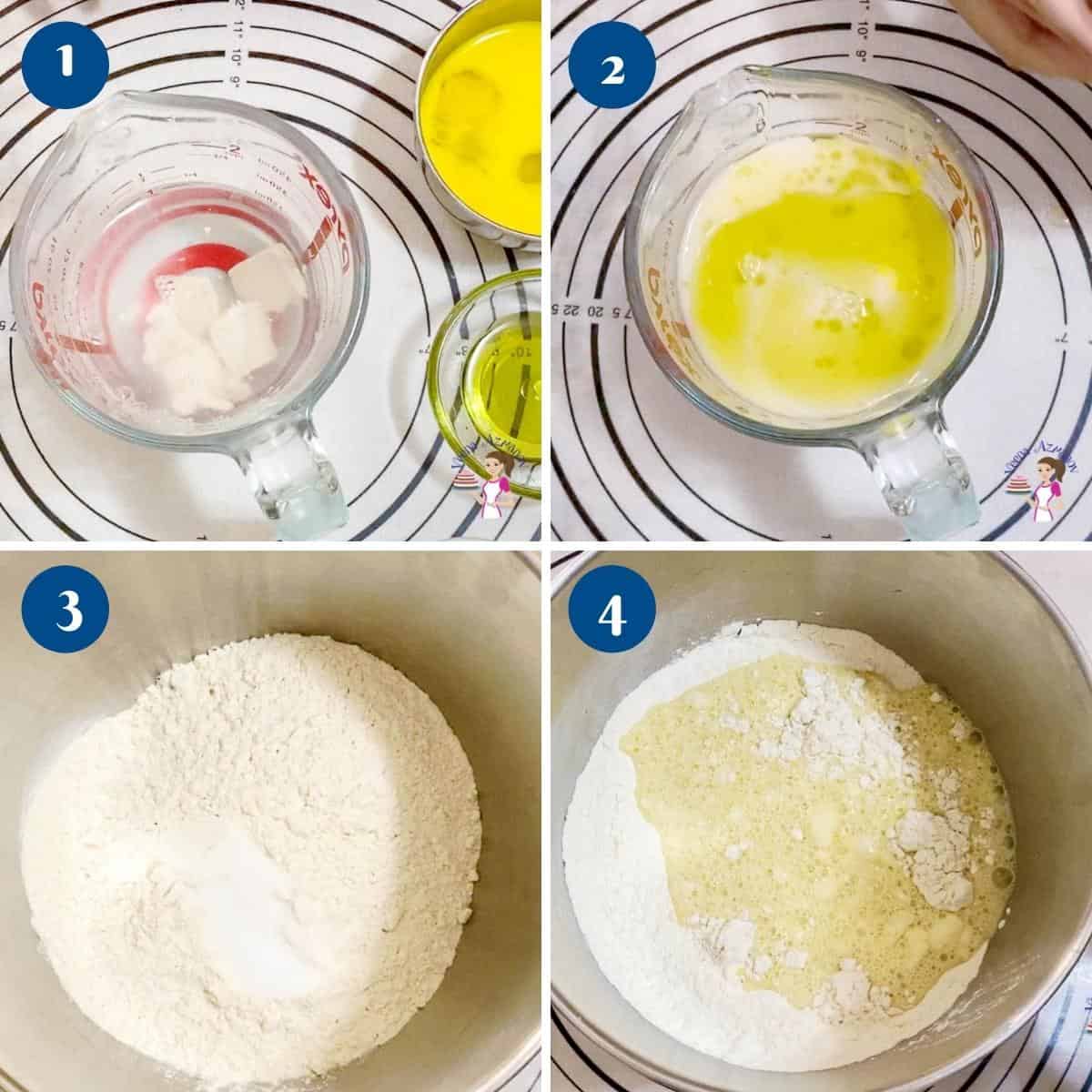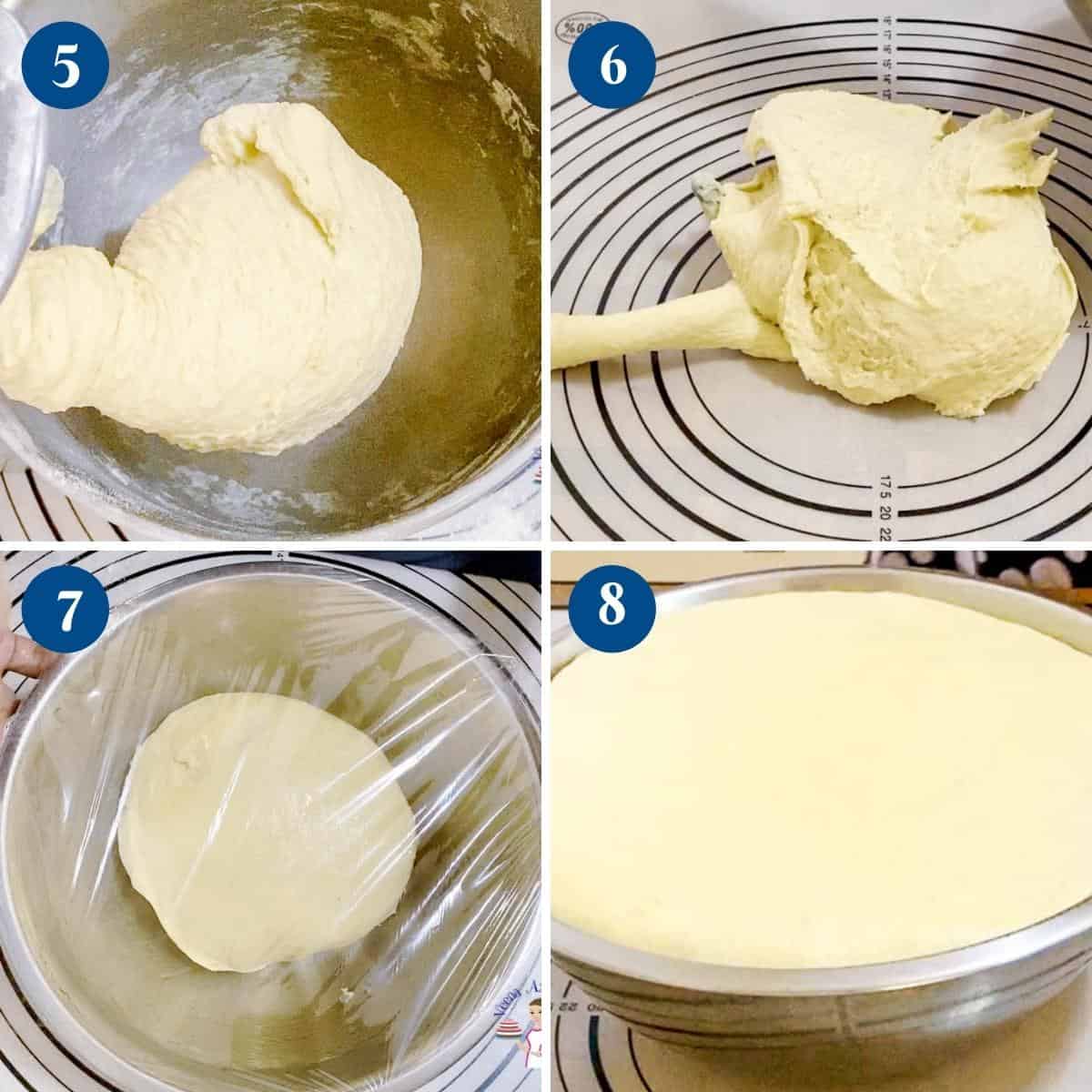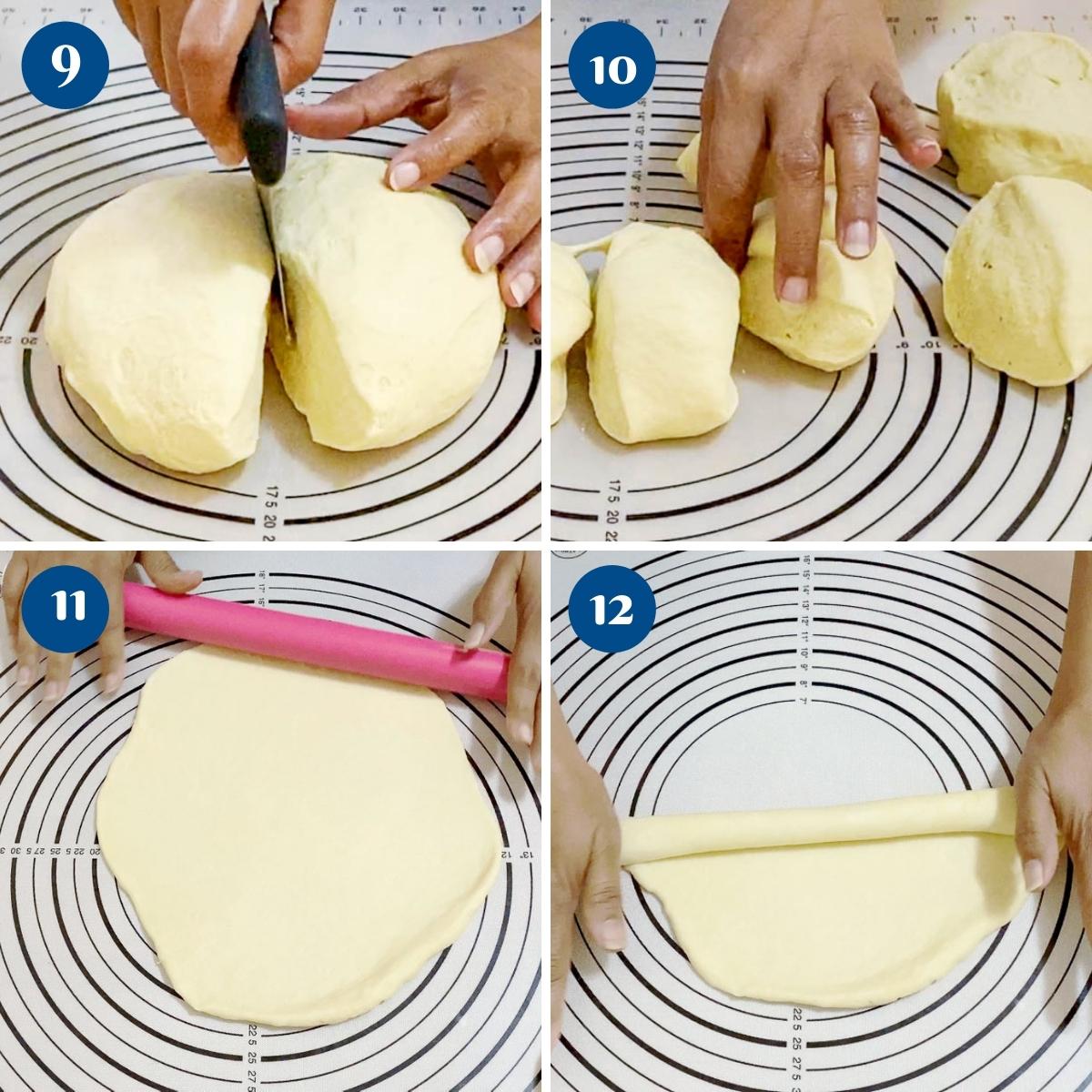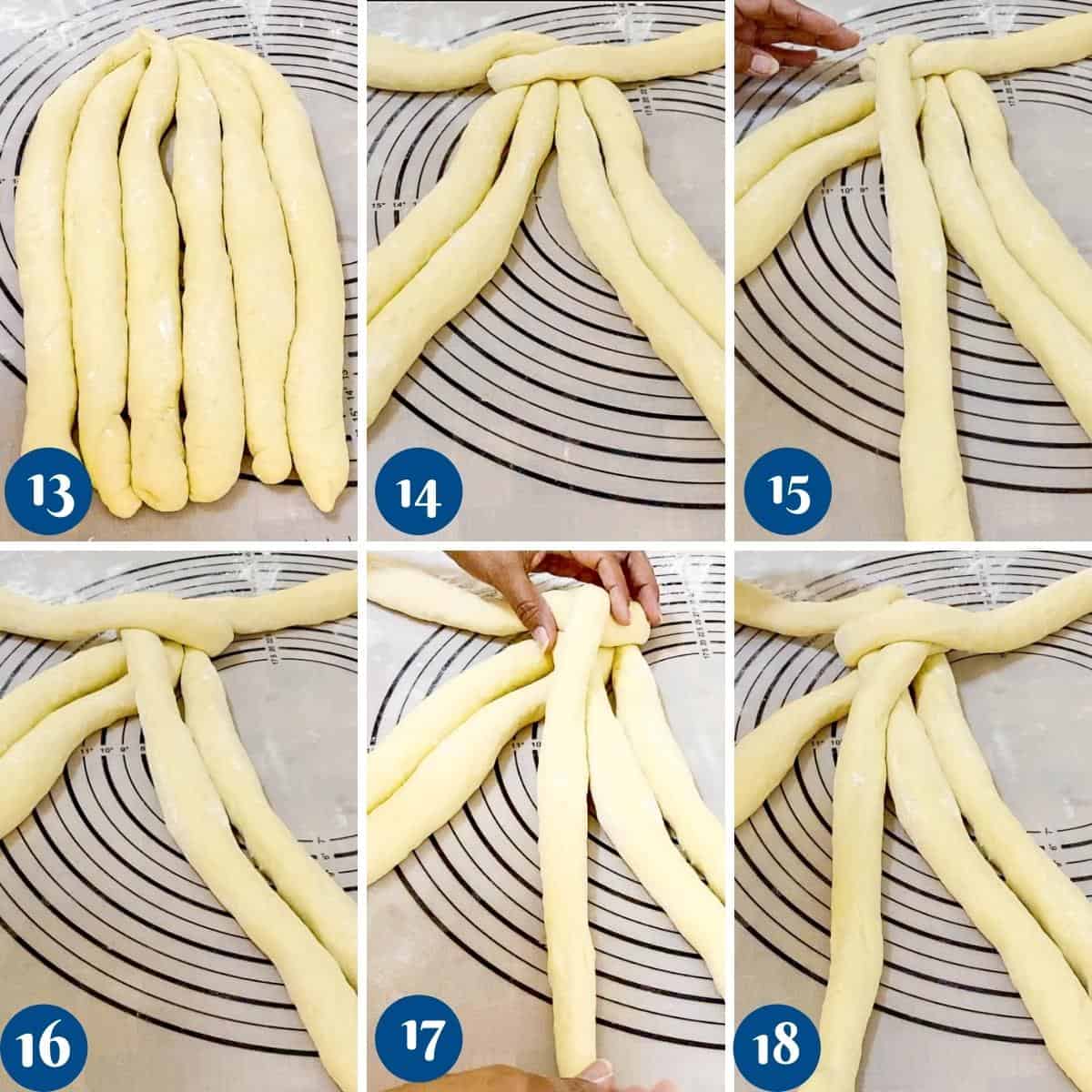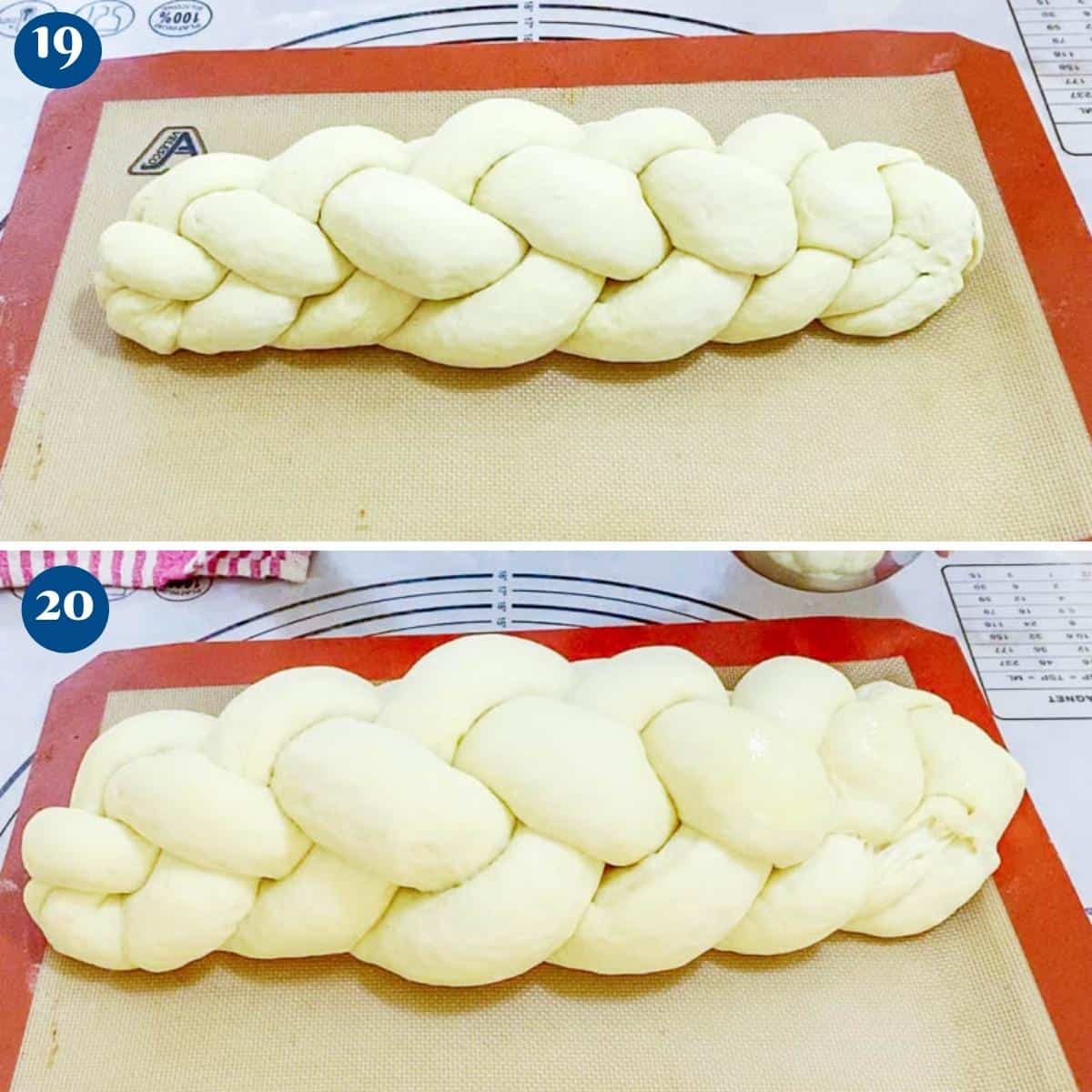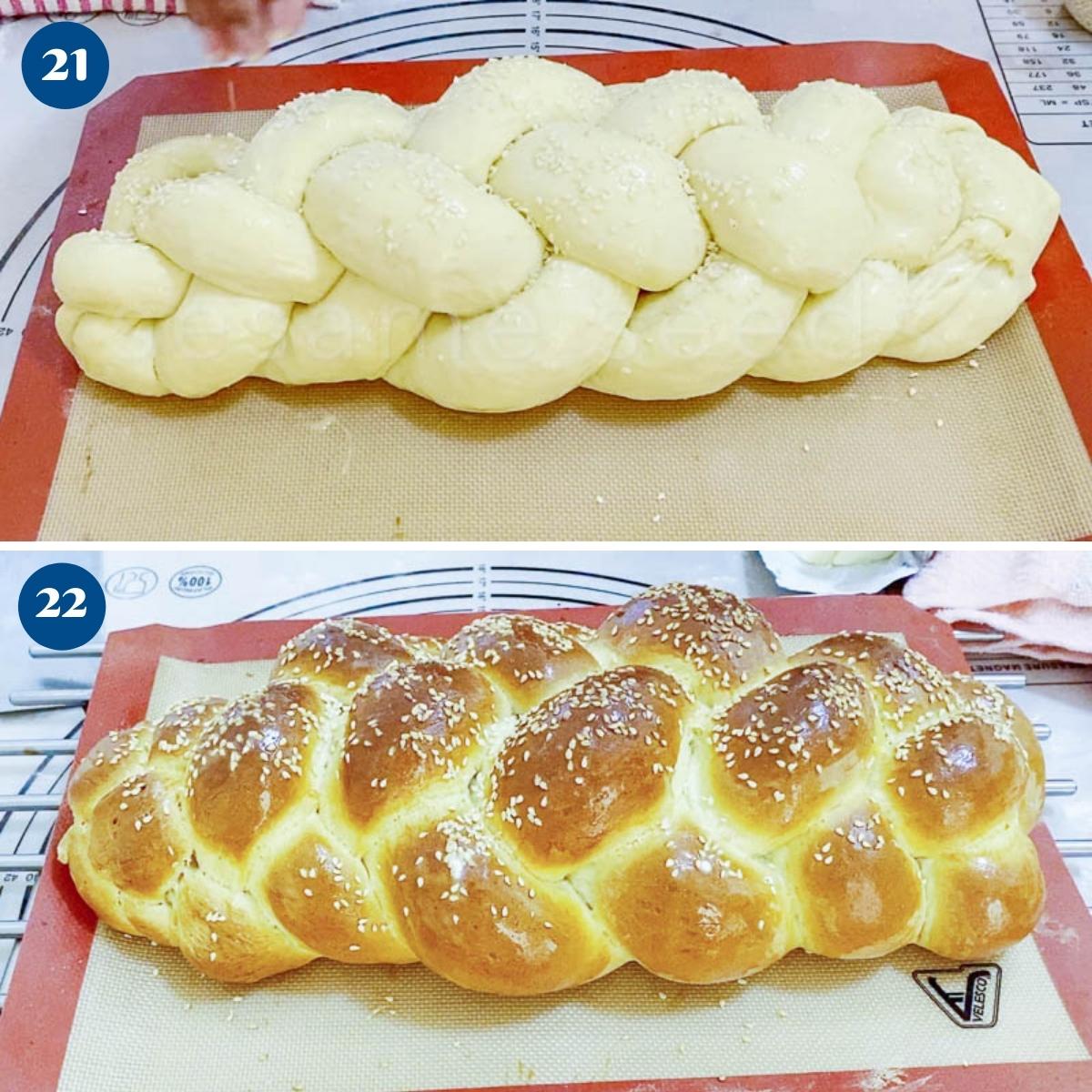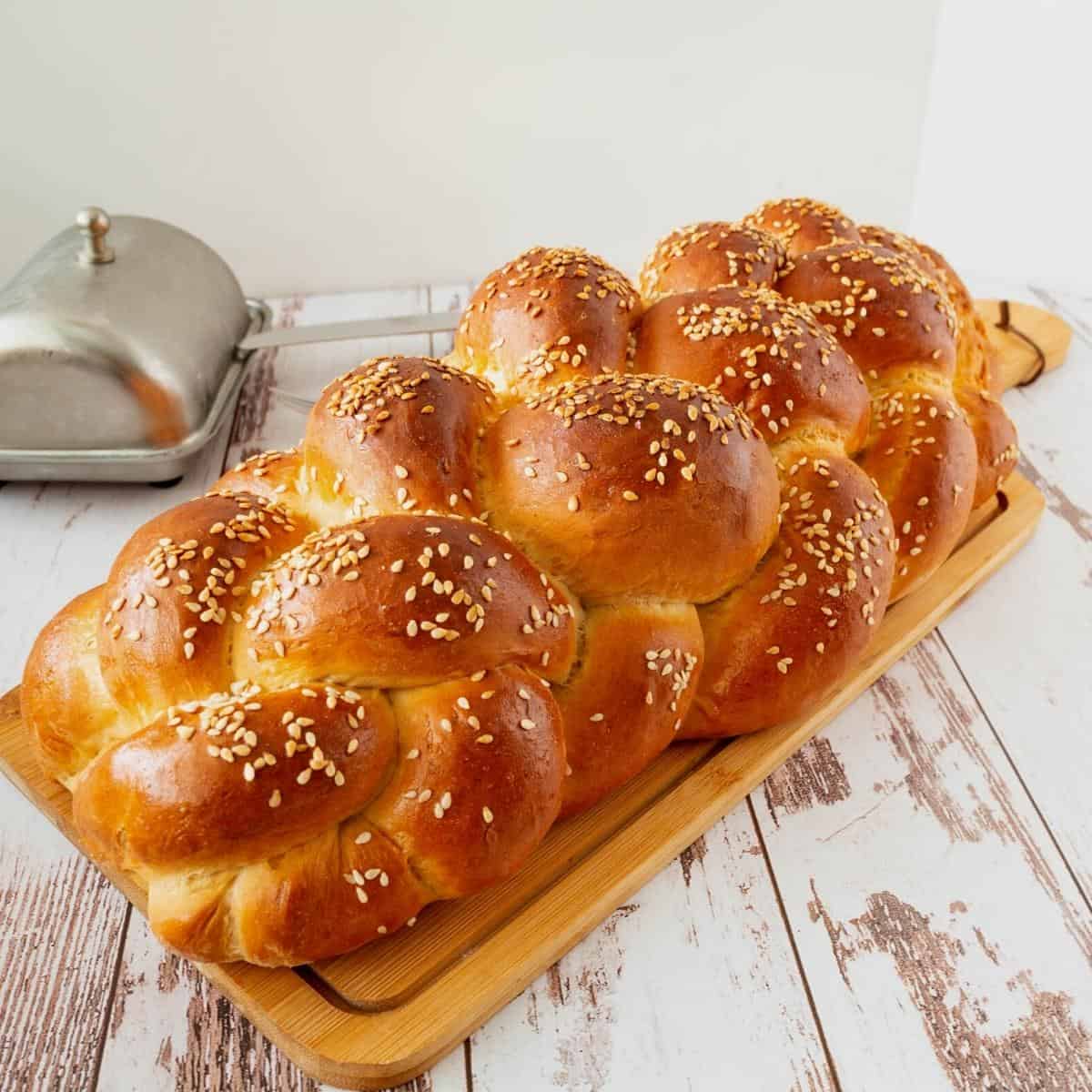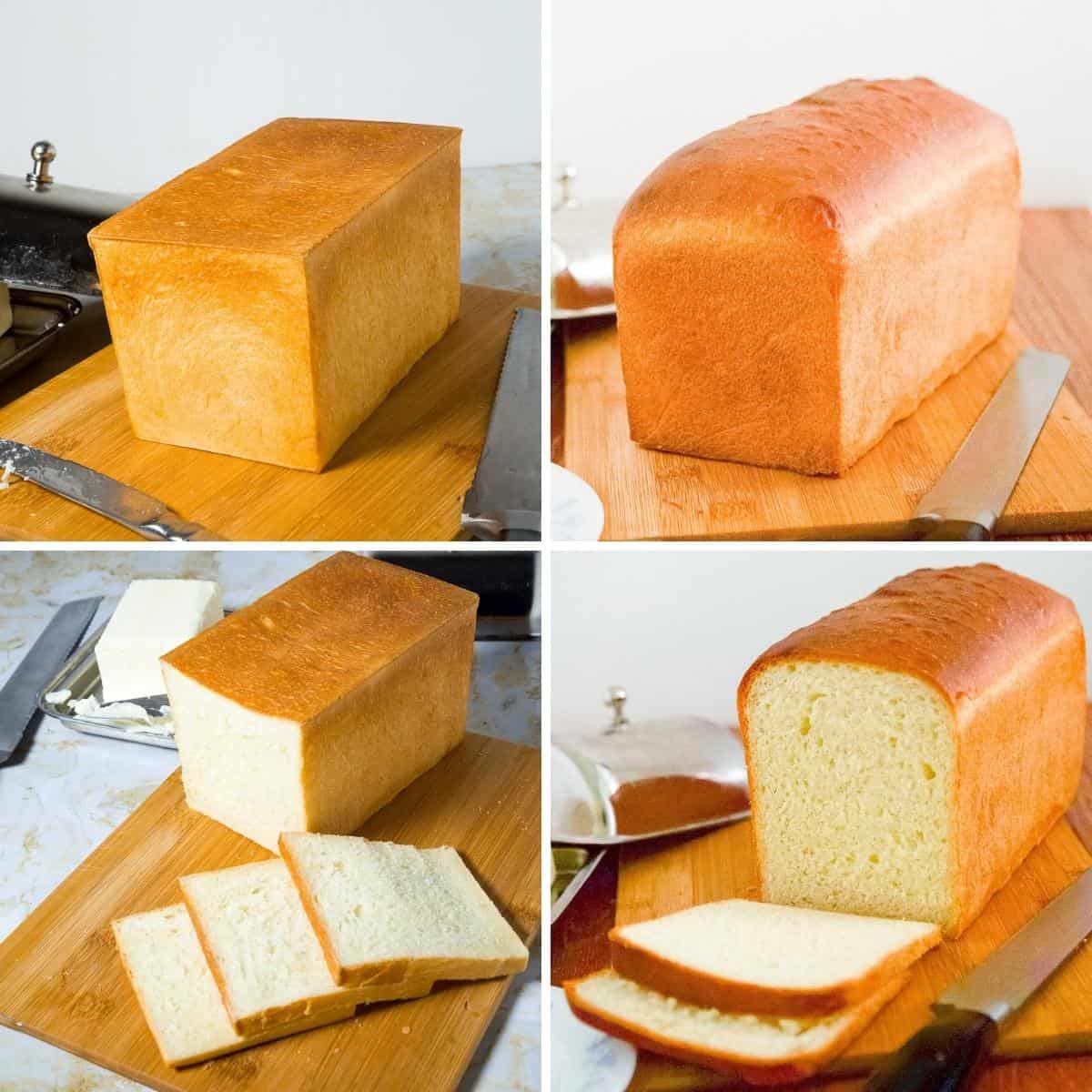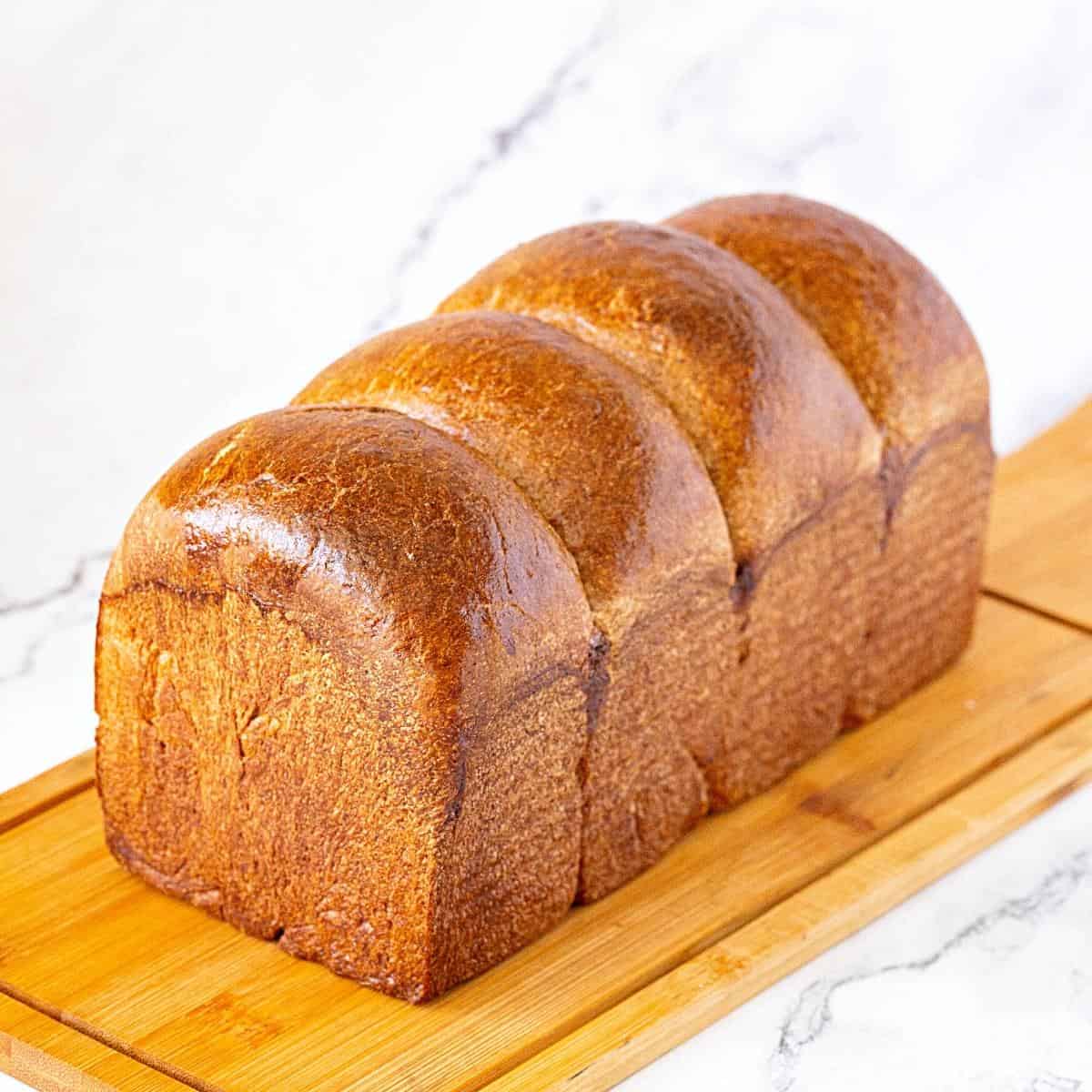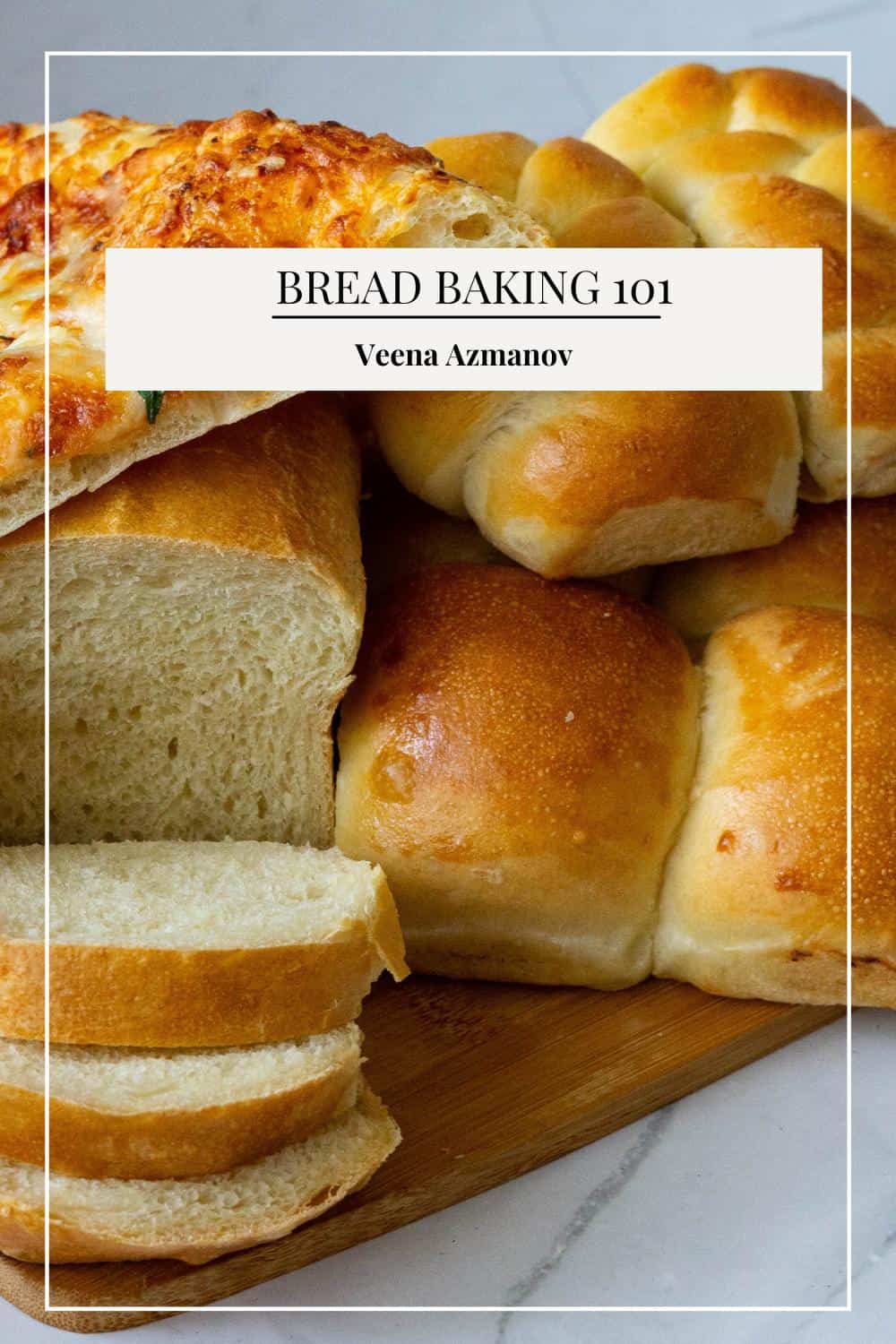Bread is a staple food made from a dough of flour, water, and other ingredients that is typically baked. It is also one of the oldest prepared foods and has been consumed by humans for thousands of years. Also, bread is usually leavened. This means it rises during the baking process due the action of leavening agents like yeast, baking powder, baking soda, etc. And the fermentation of these ingredients produces carbon dioxide gas, causing the bread to become light and airy. Bread can come in various shapes, sizes, and textures, depending on the specific recipe and baking techniques used. It can have a soft or crusty exterior and a dense or fluffy interior. Also, different types of flour, such as wheat, rye, or cornmeal, can be used to make bread. As a result, it comes in different flavors and textures. Bread is consumed in many cultures worldwide. And it is a versatile food that can be enjoyed on its own or used as a base for sandwiches, toast, and other dishes. In addition, it is a significant source of carbohydrates and provides energy and essential nutrients like protein, fiber, vitamins, and minerals. This article is your go-to guide to confidently master the art of baking bread. From understanding the common types of flour used for baking to kneading and shaping dough. Here you will gain the foundation needed to create delicious, beautiful loaves of bread easily. Also, we’ll explore the benefits of baking bread from scratch and look at some of the tools you’ll need to get started.
Frequently asked questions
Bread baking is a skill that develops with practice. So don’t let be the initial results discourage you and keep experimenting and learning from each baking experience.
Yeast Fermentation: Yeast is a crucial ingredient in bread baking. It is a microorganism that feeds on sugars in the dough and produces carbon dioxide gas through fermentation. This process causes the dough to rise and creates air pockets, giving the bread light and airy texture. Gluten Formation: Gluten is a complex protein formed when wheat flour comes into contact with water and is subjected to mechanical manipulation during kneading. In addition, gluten provides structure and elasticity to the dough. This allows the dough to trap carbon dioxide gas released by yeast and create the desired texture in the final bread. Enzymatic Activity: Enzymes, naturally present in the flour, break down starches into sugars during the dough fermentation process. And these sugars serve as food for the yeast, promoting fermentation and gas production. Heat and Oven Spring: When bread dough is placed in a hot oven, the heat causes the carbon dioxide gas trapped in the dough to expand rapidly. This creates what is known as “oven spring,” where the bread rises and expands further. As a result, the proteins in the dough coagulate, giving the bread its final structure. Maillard Reaction: The Maillard reaction is a chemical reaction that occurs between amino acids and sugars in the dough during baking. It leads to the browning of the crust, creating desirable flavors and aromas in the bread. Starch Gelatinization: As the bread bakes, the starches in the dough absorb water and undergo gelatinization. This process helps to set the structure of the bread and contributes to its moist and tender crumb. Cooling and Moisture Redistribution: Once the bread is removed from the oven, it cools. During this time, moisture redistributes within the bread, allowing it to stabilize and develop its final texture.
Understanding hydration in bread baking allows bakers to manipulate the dough’s characteristics and tailor the bread’s texture and crumb to their liking. In fact, adjusting hydration can be an advanced technique. But experimenting with different hydration levels can help bakers achieve the desired results in their bread recipes.
Hydration is crucial in bread baking as it affects the texture, crumb structure, and overall moisture content. And different hydration levels can result in varying characteristics in the final baked bread. A higher hydration level means more water to flour in the dough. This results in a more hydrated and sticky dough. Also, high hydration doughs are typically more challenging to handle and shape, but they can yield bread with an open and holey crumb, a tender texture, and a crisp crust. Conversely, a lower hydration level means less water to flour in the dough. This leads to a stiffer and less sticky dough. As a result, lower hydration doughs are easier to handle and shape and tend to produce bread with a denser crumb and a chewier texture. Hydration levels can vary depending on the type of bread and the desired outcome. For example, artisan-style bread like ciabatta or sourdough often have higher hydration levels, while bread like bagels or sandwich loaves may have lower hydration levels. Also, the hydration level is influenced by factors such as the absorption properties of the flour, the environment, and the desired dough consistency. It’s common for bakers to adjust the hydration level during the bread-making process based on these factors and personal preferences.
Gluten is a complex mixture of proteins found in wheat flour, specifically in the proteins glutenin and gliadin. When wheat flour comes into contact with water and is subjected to mechanical manipulation, such as kneading, gluten formation occurs. Also, gluten provides structure and elasticity to the dough, allowing it to trap and hold carbon dioxide gas produced by yeast during fermentation. And this trapped gas causes the dough to rise and results in the characteristic airy texture of bread. The gluten proteins have unique properties that contribute to the structure and texture of the bread. Glutenin provides strength and elasticity to the dough, while gliadin contributes to extensibility, allowing the dough to stretch without tearing. In addition, the gluten proteins align and form a network of interconnected strands during the kneading process. This network traps the gas produced by yeast and provides support to the dough as it rises. And as the bread bakes, the gluten proteins coagulate and set, creating the final structure of the bread.
So, why is gluten important?
Gluten development is essential for proper bread baking. It allows the dough to hold its shape, rise effectively, and develop a desirable crumb texture. Different types of wheat and flour have varying gluten content, which affects the characteristics of the bread. In fact, bread flour, with its higher protein content, is often preferred for bread baking as it promotes better gluten development and results in a more chewy and structured loaf. Some individuals may have gluten sensitivity or celiac disease, an autoimmune disorder triggered by gluten consumption. In such cases, alternative flours or gluten-free baking techniques can achieve similar results without using gluten-containing ingredients.
The important of rise and proof?
Time – The rise and proof stages require appropriate time and environmental conditions to allow the yeast to ferment and produce carbon dioxide gas. Also, the duration of the rise and proof can vary depending on the recipe, room temperature, and yeast activity. As a general guideline, the dough should double in size during the initial rise. And during the second proof, it should increase by about one and a half times. Monitor – It’s essential to closely monitor the rise and proof to prevent under or over-proofing. Under proofing can result in a dense texture and overproof, leading to a collapsed or excessively airy loaf.
The rise and proof stages are critical steps in bread baking. Since they allow the dough to develop flavor, texture, and volume before we bake it. Proper timing and observation during these stages contribute to the overall quality and characteristics of the final baked bread. You can start with the basics and gradually acquire additional tools as you gain more experience and confidence in baking bread.
Here are some common tools necessary for baking bread:
Mixing Bowl: Use a large mixing bowl to combine and mix the ingredients for the dough. Measuring Cups and Spoons: Accurate measurements are crucial in baking. Use measuring cups and spoons to precisely measure flour, water, yeast, salt, and other ingredients. Kitchen Scale: A kitchen scale is helpful for measuring ingredients by weight, which can provide more accurate and consistent results, especially when working with bread recipes that use weight measurements. Dough Scraper/Bench Scraper: A dough scraper or bench scraper handles sticky dough, divides dough portions, and cleans your work surface. Wooden Spoon or Dough Whisk: Use a wooden spoon or dough whisk to mix the dough and combine the ingredients before kneading. Stand Mixer with Dough Hook (optional): While not essential, a stand mixer with a dough hook attachment can make kneading easier and less labor-intensive, especially for larger batches of dough. Pastry Brush: A pastry brush is helpful for applying egg wash or butter to the bread’s surface to enhance browning and add flavor. Banneton or Proofing Basket: A banneton or proofing basket is made of cane or other natural materials that helps shape and support the dough during the final proofing stage. It adds texture to the crust and helps the bread retain its shape. Baking Sheet or Loaf Pans: Baking sheets or loaf pans hold and shape the dough during the final rise and baking. Oven Thermometer: An oven thermometer ensures that your oven is at the correct temperature, as oven thermostats can be inconsistent. This helps achieve the desired baking results. Cooling Rack: After baking, a cooling rack allows air to circulate the bread, preventing moisture buildup and keeping the crust crisp.
Additional tools that can be handy but are not essential include a bread knife or sharp knife for scoring the bread, a spray bottle for creating steam in the oven, and a pizza stone or baking stone for even heat distribution.
Flour: Flour is the primary ingredient in bread baking and provides the structure and bulk of the bread. Common types of flour used in bread making include all-purpose flour, bread flour, whole wheat flour, and rye flour. And each type of flour has different protein content, which affects the gluten development and texture of the bread. Water: Water is essential for hydrating the flour and activating the yeast. It helps form gluten strands and allows the dough to rise properly during fermentation. Yeast: Yeast is a microorganism that causes the dough to rise by fermenting the sugars in the flour, producing carbon dioxide gas. It is available in both dry (active dry yeast or instant yeast) and fresh forms. Yeast provides the bread with a light and airy texture. Salt: We add salt to enhance the flavor of the bread. It also helps control yeast activity and gluten development. Additionally, salt plays a role in regulating fermentation and improving the shelf life of the bread.
Additional ingredients
The following ingredients are often used in enriched bread recipes to affect flavor, texture, and shelf life.
Sugar: Sugar serves as food for the yeast and helps speed up the fermentation process. It also contributes to browning and crust formation. Also, you can use different types of sugars, such as granulated sugar, honey, or molasses, to add sweetness and flavor to the bread. Fats: You can addfFats, such as butter, oil, or shortening, to the dough to enhance its texture, tenderness, and flavor. Also, fats help extend the shelf life of the bread by slowing down staling. Eggs: We sometimes use eggs in bread baking to enrich the dough, providing added moisture, structure, and richness to the bread. Milk or Dairy Products: You can add milk or dairy products, such as milk, buttermilk, or yogurt, to the dough to add tenderness and flavor to the bread.
These ingredients, combined with proper mixing, kneading, fermentation, and baking techniques, contribute to the creation of delicious and well-textured bread. Experimenting with different types of flour can yield unique flavors and textures in your homemade bread. Here are some of the most commonly used types of flour for bread baking:
Mixing: The initial stage involves combining the flour, water, yeast, salt, and other ingredients in a mixing bowl. Then, we mix the ingredients together until a cohesive dough forms.
Kneading: Kneading is a crucial step that develops the gluten in the dough, giving it structure and elasticity. The dough is stretched, folded, and pushed using the hands or a stand mixer with a dough hook. Kneading continues until the dough becomes smooth and supple and springs back when gently pressed.
Fermentation (First Rise): After kneading, we allow the dough to rest and ferment. During this stage, the yeast converts the sugars in the dough into carbon dioxide and alcohol through fermentation. We cover the dough and leave it in a warm place for a specific period, typically until it has doubled. This first rise allows the dough to develop flavor and texture.
Shaping: Once the dough has completed its first rise, it is shaped into the desired form. The dough is gently deflated, shaped into a loaf, rolls, or other desired shapes, and placed on a baking sheet or in a loaf pan. Proper shaping helps create a well-structured final product.
Proofing (Second Rise): After shaping, the dough undergoes a second rise called proofing. This stage allows the dough to rise again, typically until it has increased in size by about one and a half times. During proofing, the yeast ferments, producing more carbon dioxide and creating air pockets in the dough. This rise contributes to the final baked bread’s lighter and fluffier texture.
Baking: The proofed dough is transferred to the oven for baking. The oven is preheated to the appropriate temperature, typically around 375°F to 450°F (190°C to 230°C). The high heat causes the yeast to produce a final burst of gas, expanding the dough further. Baking also sets the structure of the dough, creates a golden crust, and imparts flavor through caramelization and Maillard reactions.
Cooling: After baking, we remove the bread from the oven and allow it to cool on a wire rack. Cooling is essential for the bread to set and finish its cooking process. And it also helps prevent moisture buildup, resulting in a crisp crust.
The baking time also varies based on the recipe, loaf size, and oven temperature. On average, a standard loaf of bread may take around 25 to 45 minutes to bake. However, larger loaves or specialty bread like sourdough may require longer baking times, while smaller rolls or baguettes may bake in a shorter time. It’s always best to follow the specific instructions provided in your chosen recipe. Typically, the recipe gives you the recommended oven temperature and baking time. This ensures that you bake the bread correctly and safely. And to ensure that you bake the bread thoroughly, you can also check for doneness by tapping the bottom of the loaf or inserting an instant-read thermometer into the center. The internal temperature should ideally reach around 190°F to 200°F (88°C to 93°C) for most bread types. Remember that baking times and temperatures can vary, so monitoring the bread closely, especially during the last few minutes of baking, is crucial to avoid under or over-baking. Adjustments may be necessary based on your specific oven’s performance and your desired crust and texture preferences.
Baguette: A long, narrow French bread with a crisp crust and a soft interior. You can use it for making sandwiches or serving it with soups and stews. Sourdough: A bread made from a fermented dough using naturally occurring lactobacilli and yeast. It has a tangy flavor and a chewy texture. Whole Wheat: Bread made from flour that includes the wheat grain provides more fiber and nutrients than white bread. It has a dense texture and a nutty flavor. Rye: A bread made primarily from rye flour, which gives it a distinct flavor. It can be light or dark in color, and New York City delis use it to make some of their famous sandwiches. Ciabatta: An Italian bread with a crispy crust and a soft, airy interior. It is often used for making sandwiches or served alongside pasta dishes. Pita: A round, flatbread from the Middle East. It is characterized by its hollow interior, which can be filled with various ingredients to make sandwiches or used as a dipper. Focaccia: An Italian bread similar to pizza dough, typically topped with olive oil, herbs, and sometimes vegetables or cheese. It has a light and fluffy texture. Challah: A traditional Jewish bread made with eggs, giving it a rich flavor and a soft, slightly sweet taste. It is often braided and served on special occasions. Naan: A soft and fluffy Indian bread, typically made with wheat flour and baked in a tandoor (a clay oven). It is famous for accompanying curries and other Indian dishes. Brioche: A French bread enriched with butter and eggs, resulting in a tender crumb and a slightly sweet taste. We commonly use it for making pastries and desserts.
These are just a few examples of the wide variety of bread types available. Different cultures and regions have their own unique bread recipes and traditions, making bread a versatile and delicious staple in many cuisines.
What is the simplest bread to make?
This basic white bread recipe is a great starting point for beginners and produces a delicious homemade loaf. Feel free to experiment and add variations such as seeds, herbs, or whole wheat flour to customize the bread to your taste. However, it’s important to note that baking is also an art, and experience and experimentation play a significant role in achieving the perfect loaf of bread. Enjoy your freshly baked bread! Did you LIKE this recipe? Save it for later. You can find my recipes on Pinterest. Follow me on Facebook, Twitter, and Instagram.Subscribe, and I’ll send you new recipes right to your inbox. Thank you for sharing - Save for later

